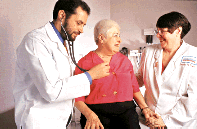PATIENT CARE: Putting Patients First
 Dr. Hagop Kantarjian, Chief of the leukemia section, examines patient
Lorraine Lalumandier of Baton Rouge, Louisiana, in the Hematology Center, as nurse Rona
Dorn provides support.
Dr. Hagop Kantarjian, Chief of the leukemia section, examines patient
Lorraine Lalumandier of Baton Rouge, Louisiana, in the Hematology Center, as nurse Rona
Dorn provides support.Facts on Patient Care
PATIENT CARE: Putting Patients First
 Dr. Hagop Kantarjian, Chief of the leukemia section, examines patient
Lorraine Lalumandier of Baton Rouge, Louisiana, in the Hematology Center, as nurse Rona
Dorn provides support.
Dr. Hagop Kantarjian, Chief of the leukemia section, examines patient
Lorraine Lalumandier of Baton Rouge, Louisiana, in the Hematology Center, as nurse Rona
Dorn provides support.Facts on Patient Care
Return to Winter 98